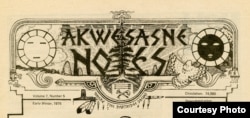The collapse of a prominent Native American media network has triggered debate over how Native media can best serve the interests of communities across Indian Country and counter stereotypes and misinformation in the mainstream press.
Native American journalism dates back to the Cherokee Phoenix, founded in 1828 to advocate against the U.S. government policy of assimilation and forced removal. Many newspapers have since come and gone, victims of high costs and low revenue.
The most recent casualty was Indian Country Today Media Network (ICTMN), whose publisher, Ray Halbritter of the Oneida Indian Nation, this month announced that after 36 years in business, the network would take a break to explore “alternative business models.”
The news disappointed many, who surmised that the venture was too costly to support.
“This is a really tough environment for anyone that’s in the advertising side, and Indian Country Today was selling advertising,” said independent journalist and blogger Mark Trahant.
Others suggest ICTMN failed because it lost touch with the audience it intended to serve.
Humble beginnings
ICTMN began as the Lakota Times, founded in 1981 by Oglala Lakota journalist and editor Tim Giago, serving South Dakota’s Pine Ridge Indian Reservation. A weekly community newspaper, independently owned, it gradually expanded its coverage to national issues and was renamed Indian Country Today.
New York State’s Oneida Nation, a tribe which has profited through the gaming industry, bought the paper in 1998. They later renamed it ICTMN and moved operations to New York City. In 2013, they ended the print edition and shifted online. Last April, ICTMN launched a glossy, bimonthly magazine, Indian Country, at considerable expense.
“One of the things I think they forgot was all these folks here in Pine Ridge, Rosebud, Cheyenne River, Crow Creek or Standing Rock reservations,” said Giago, now publisher of Native Sun News Today. “They live way out in the middle of nowhere. A lot of them don’t have money to buy computers, least of all to hook up to the internet.”
Giago and others have also criticized ICTMN for hiring non-Native American writers and editors.
“Most of the other Native publications over the past couple of generations were written and edited by people who were deeply involved in their respective communities,” said Mohawk journalist Doug George-Kanentiio, vice president of the Hiawatha Institute for Indigenous Knowledge and a former editor of the now-defunct newspaper Akwesasne Notes.
He also questioned whether a network owned and funded by a tribal government could guarantee editorial independence.
“Whoever is writing the checks by and large determines the content,” he said.
‘Crabs in a bucket’
ICTMN op/ed editor Raymond Cook bristles at the criticisms.
“People always poke at success,” he said, citing the analogy of crabs in a bucket, “where one crab is trying to get out of the bucket, and then the others pull him down.”
First, he explained why ICTMN shut down.
“The state of New York recently handed out several gaming licenses, and now these non-tribal entities are trying to creep into the casino market,” he said. “So, the Oneida had to readjust its revenue projections. And reluctantly, with tears in their eyes, they put us on hiatus.”
He denies ICTMN lost touch with tribes.
“New York City has a larger Native American population than any other U.S. city,” he said. “So we never moved out of Indian Country. If we had stayed in South Dakota, we’d still be waiting for internet connection.”
He defends ICTMN for hiring non-native writers, whom he calls ‘indigenous identifiers,’ as well as targeting non-Native audiences.
“’Cause we can’t talk to ourselves only,” he said.
The paper regularly interviewed prominent U.S. politicians, including President Barack Obama.
“We not only educated our readers on the views of these politicians on Indian-focused issues, but we also helped ensure that Native America was on the radar of many of the top power brokers in our country and beyond,” said ICTMN’s Washington bureau chief Rob Capriccioso, a member of the Sault Tribe of Chippewa Indians.
Looking forward
At their recent annual meeting, members of the Native American Journalists Association discussed setting up a national Native American wire service to serve both tribal and mainstream media.
“Instead of trying to create a new vehicle, we’d just create a new driver,” journalist Trahant said.
In the meantime, ICTMN’s Cook said his network is looking for a qualified party to take over operations, something that would require an annual investment of $2.5 million to $3 million until 2021.
“Basically, we’d sell it to them for $10, and they can take over operations, as long as they can guarantee our journalistic standards,” he said. “It could be a tribe, a business, a government -- anything, as long as it’s based in Indian Country and it’s run by Natives.”












